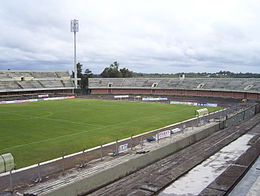 | |
 | |
| Location | Rivera, Uruguay |
|---|---|
| Coordinates | 30°54′30″S55°32′54″W / 30.90833°S 55.54833°W |
| Capacity | 27,135 [1] |
| Field size | 100 × 60 m |
| Surface | grass |
| Construction | |
| Opened | 1927 |
| Expanded | 1995 |
| Tenants | |
| Uruguay national football team (some matches) Frontera Rivera Chico | |
Estadio Atilio Paiva Olivera is a multi-use stadium in Rivera, Uruguay. It is currently used mostly for football matches.
The stadium holds 27,135 people. [2] It was used for the 1995 Copa América and the 1999 South American Under-17 Football Championship.
On 23 June 2011, Uruguay played a friendly match in this stadium against Estonia where the locals won 3–0. [3]